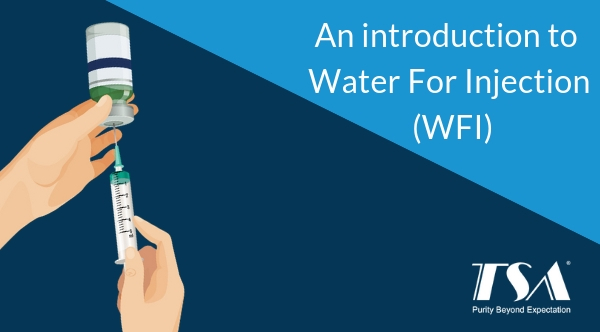What is Water for Injection (WFI)?

Water is an important aspect to all life on earth. Even the human body is made up of 60% water. This fact makes it easier for doctors and other healthcare specialists to administer drugs directly in to the human body. This is achieved by dissolving the drugs in water; preparing a solution of the drugs and administering it via injections and other intravenous mediums. Hence, it becomes imperative that we use water that is purified using appropriate processes. We define the water that is used for these processes as Water for Injection or WFI water. Thus, WFI can be defined as water that is used in manufacture of parenteral (injectable) drugs whose solvent is water. The United States Pharmacopeia (USP) defines this as a highly purified water containing less than 10 CFU/100 ml of Aerobic bacteria. WFI has stricter bacteria controls than purified water and hence the USP mandates these waters should have less than 500 ppb of total organic carbon, fewer than 0.25 EU/ml endotoxins, and a conductivity of less than 1.3 uS/cm @ 25 C.
These are textbook definitions of WFI, now we will take a better look at how it’s made and some common process equipment used to make WFI. Pharmaceutical companies can adopt any of the two means defined by the USP to produce WFI; either distillation or reverse osmosis. Before companies can start producing WFI they need to make sure that the source water used is up to appropriate standards. Pre-treated water is used to make WFI. Pre-treatment of water aims to remove various ionic and organic compounds. This is achieved by having the water go through multiple filtration processes designed with ion exchange resins that use activated carbon beds. The primary objective behind pre-treating water is to reduce conductivity and level of organic compounds.
There are several methods to pre-treat water, dechlorination, as the name suggests, is one where chlorine is removed from the water. This is effected by running the water through activated carbon media. The carbon reacts with the free chlorine in water to form hydrochloric acid and carbon monoxide/dioxide and effectively dechlorinates it. Pharmaceutical processes use carbon to dechlorinate pre-treated WFI. This pre-treatment of water aims to make the source water free from ions and organic compounds.
Once water is pre-treated, it is sent to the still. The WFI still is where the water is purified and WFI is produced. In the water still, the water is heated until it is a vapour, and all that is left behind are heavier impurities. This method is called distillation. Distillation intends to remove various ions, particulates, and endotoxins from the water. The water vapour is passed through a series of tubes and recondensed resulting in WFI. There are single and multiple effect stills available, and which is best for you depends on your purity requirement for WFI. Regardless of the kind of still used, the basic process remains the same, water is converted in to vapour leaving behind all the heavier ionic and particulate impurities.
Once we are done with producing WFI, what do we do with it? It either needs to used quickly (usually within a day) or appropriate steps need to be taken to ensure the water stays at WFI purity levels. How is it done? The primary focus is to minimize bacterial growth. This is accomplished by maintaining it at a high temperature and keeping it in motion. WFI is usually kept at 90 degrees C and run constantly through a distribution loop at a velocity of 5 feet per second. This ensures that WFI produced stays at the highest purity levels and does not degrade due to contamination. Now to avoid any external contamination, all the equipment’s used in the distribution and storage systems need to be sterile. Any ventilation or vent filters are also sterile membranes of at least 0.2 uM. In industrial water treatment process the company uses wfi water.
Other common place equipment used to ensure water quality integrity are double sheet shell and tube heat exchangers. Since the conductivity of WFI is low, it is always ready to absorb ions from any surface it comes in contact with. To mitigate this, water systems are integrated with centrifugal pumps with single or double mechanical seals and hard seal faces made from silicon carbide or tungsten carbide. This ensure that the WFI does not leech ions out of any surface. With wfi water industries are using multi column distillation plants.